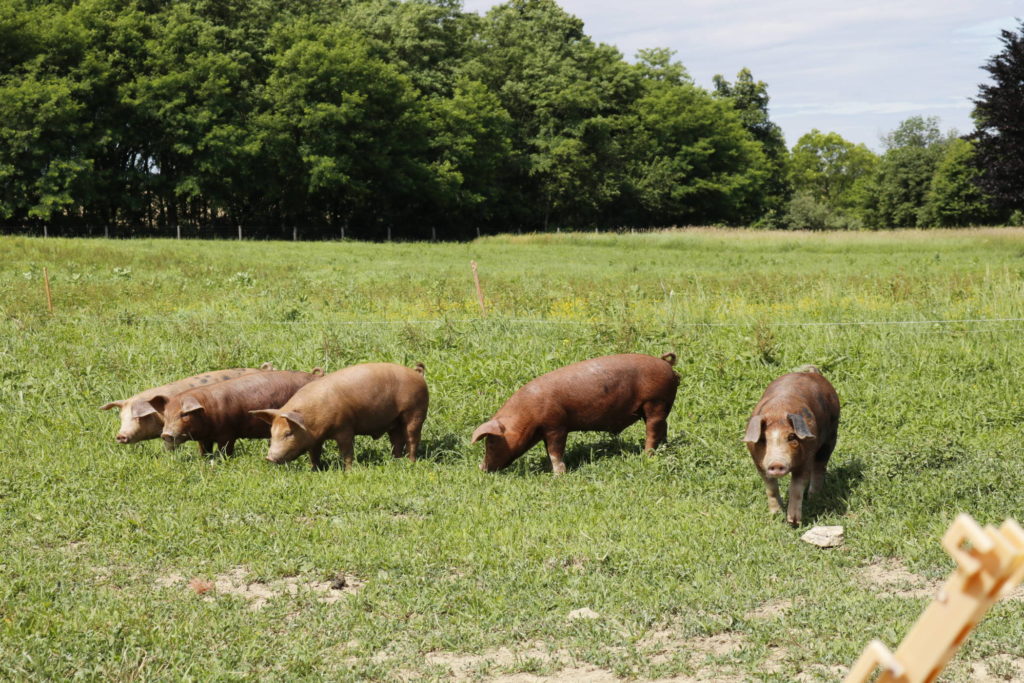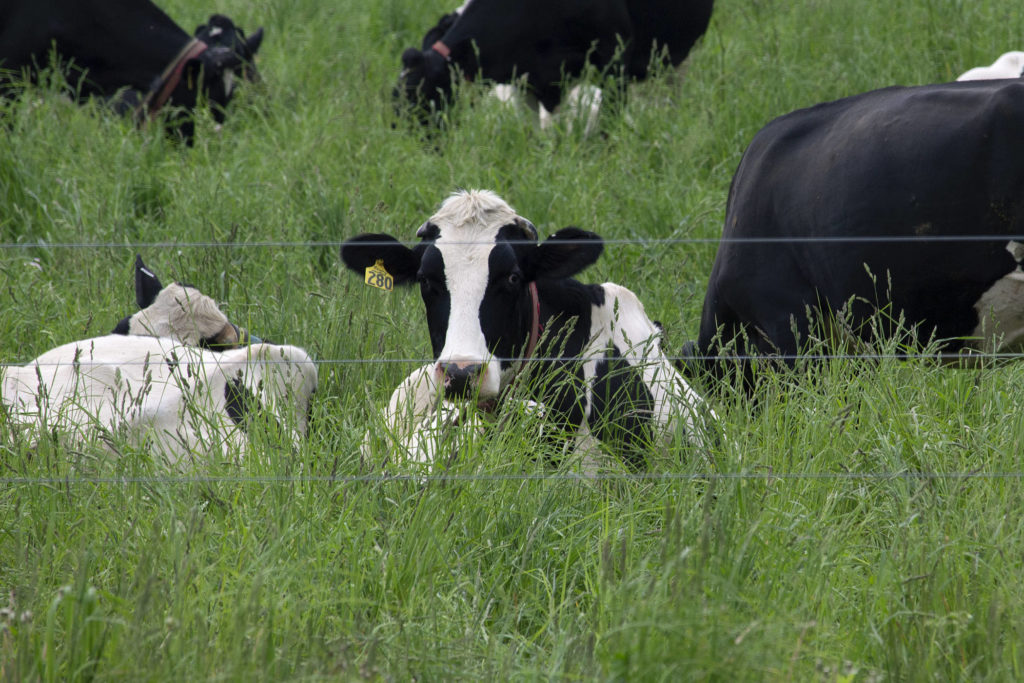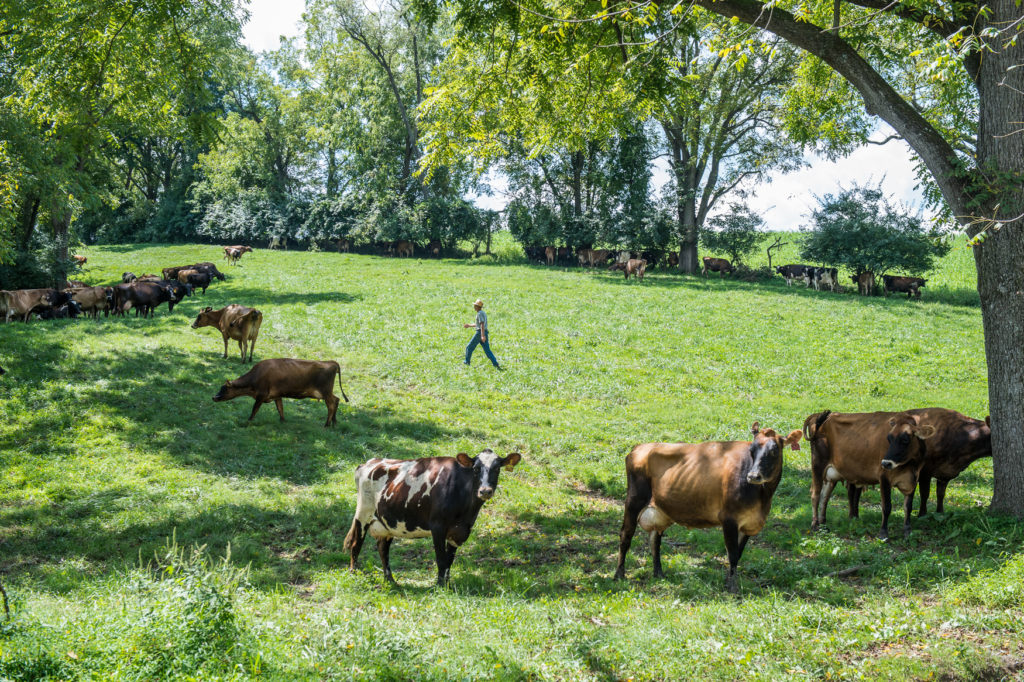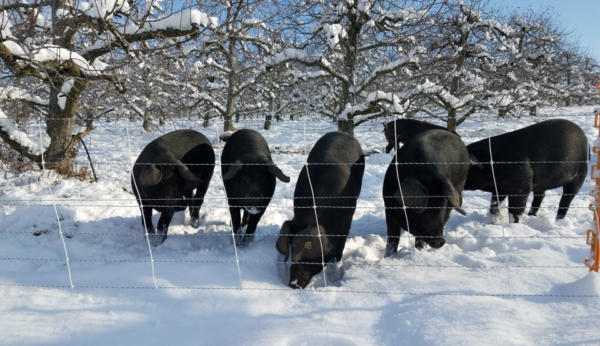As an all grass, no-grain dairy, we pay close attention to our grazing. Our experience with transitioning from management intensive grazing (MIG) to Holistic Management planned grazing on Cimarron Farm has been rewarding. I am confident that planned grazing gives us the best results possible, and things just keep getting better. Some benefits that should be noted up front include:
- Everybody on the farm enjoys taking a few days during the cold of winter to contribute to a plan that they can see and work with through the whole season.
- The cattle end up where they are supposed to be, when they are supposed to be there. Thinking through the year beforehand often opens up new possibilities that we hadn’t considered previously.
- We don’t “run out of grass” or commit what Andre Voisin termed “untoward acceleration” during slow growth periods, as we have planned moves based on slow growth. (“Untoward acceleration” is the situation where each successive grazing period provides less forage, and the recovery period is thus successively shortened until most plants in most paddocks are overgrazed and there is no feed left.)
- Animal performance keeps improving, and recovery periods keep decreasing.
- Grazing planning is a great way to “enter the mind of the land”….we approach it like a game of biological chess in which everyone wins.
The basic ecological principles outlined in Holistic Management have also led us to experiment with some grazing and soil-building strategies that differ from management-intensive grazing convention in these parts. The results have been encouraging and are the main subject of this article.
I will qualify what follows by noting that we are located in non-brittle Vermont, we are running cows (about 70 mature cows and 40 young stock, this year) and this farm was rotationally grazed for 20 years prior to planning our grazing. I write in the spirit of experimentation. We have made changes in management that have yielded positive results. We are still monitoring!
Grazing tall improves forage, topsoil and growth rates
The standard advice in management intensive grazing circles is to graze 4- to 8-inch (100-200 mm) pastures down to 1-3 inches (25-75 mm). Reasons offered include even re-growth, high digestibility, high protein for high milk and meat production, avoidance of pokey stems causing pink-eye, higher clover content due to less light competition and better water cycling due to less leaf transpiration.
This strategy comes with built-in problems. Our challenge in lush pasture grazing is to provide enough energy to balance the very high levels of “protein,” including non-protein nitrogen. When stock are forced to eat short, lush, high-protein pasture, the microbes in the gut still need to get energy from somewhere, so amino acids, proteins, etc., are deaminized to get at the energy stored in underlying carbon bonds (i.e. protein is turned into energy). Energy is freed up, but the cost is ammonia, which is toxic to the animal, and which the liver and kidneys are forced to deal with. It takes a lot of energy to run those filters. Additionally, oxygen in the blood is replaced by ammonia, in effect leading to oxygen starvation.
Mark Bader of Free Choice Enterprises was the first to alert us to the fact that by grazing very lush pasture, we were creating alkalosis in the herd. The smell of ammonia in the milking parlor was very strong, and the manure was similar to green paint.
Classic pasture dynamics writer Andre Voisin also warned about the dangers of non-protein nitrogen in Grass Productivity. Nutritionist Jerry Brunetti of Agri-Dynamics helps grass farmers manage for forage that minimizes “funny protein.”

To counter the negative effects of low fiber and alkalosis that result from grazing such immature pasture, most producers around here feed supplemental hay, silage and grain during the grazing season. Having chosen to pursue the all-pasture path, we determined to figure out how to better meet the nutritional needs of the stock entirely in the pasture. This led us to experiment with “grazing tall.” (We should note that we do feed free-choice minerals, as well as supplement apple-cider vinegar at the rate of 2-3 oz/head/day in the drinking water.) For more information on the benefits of cider vinegar as a supplement for livestock, see D.C. Jarvis’ book Folk Medicine.
The increased grass production and enhanced soil biology benefits of the “grazing tall” strategy, though not called this, are laid out in the chapter on energy flow in Holistic Management by Allan Savory. In practice, we let pasture grow up to about early boot stage (at least 12 inches tall, usually taller), graze at high stock density, and leave a well trampled, high residual (say 4 to 7 inches). We still generally achieve 55 ADA (animal days per acre per grazing cycle), but the harvested forage is shifted higher up on the plant.
This practice keeps growth in the steepest part of the sigmoid curve (that characterizes the varying growth stages of grass during the season) rather than repeatedly knocking the grass back to the bottom, shallow slope of the S-curve. Grazing tall leaves lots of leaf area to kick-start re-growth through aboveground energy reserves and photosynthesis.
Our maximum recovery period dropped from 60 days to 45 days in one year when we began grazing tall. Other factors, such as spring management, also figured into this.
Roots go deeper, moisture retained
Grazing tall results in much more developed root systems, deepening the topsoil-building zone and enhancing mineral cycling. Carbon is deposited deep in the soil both through root prune-off after grazing, as well as through nightly carbon exudates from the plant into the rhizosphere.
The greater depth of root development is a plus during dry spells, as roots can tap deep water in soils. It also leaves a nice mulch layer that seems to reduce soil drying/evaporation, so water cycling is generally enhanced.
Malcolm Beck points out that the dense litter that results from trampled residual also leads to high levels of CO2 from litter decay in the pasture tangle, which localizes and accelerates carbon cycling and keeps leaf stomata closed longer and more often, thus reducing transpiration. This makes sense to us, and our experience confirms it.
Grazing higher on the sigmoid curve is where we find the best energy/protein ratio, and it accounts for some of our better animal performance. With our cooler weather here in the Northeast, we have fewer problems with lignification than grass farmers in warmer climes.

Allowing the animals to graze the top portions of the plant and leave the bottoms also increases the energy levels in the grazed forage. As the cows happily graze the tops of the pasture plants, I suspect they are telling us that glucose levels are highest in the upper portions of the plant, where photosynthesis is actively occurring.
Grazing at high density (we aim for stock density of between 400-800 animals/acre or 1,000-2,000 animals/ha) tramples most everything down, and results in even re-growth, not at all clumpy, even when the grass we turn the animals into is over-mature. It means a lot of moves in the course of a day, but that is the best part of our job.
High stock density is not generally used in management intensive grazing, but we have found it to pay off. Clipping pastures to deal with “clumpiness” is becoming a dim memory.
Fall management key to spring and summer growth
Jim Howell’s article on Llewellyn Manske’s research into rangeland ecology at North Dakota State University was an eye-opener for us. The realization that the secondary tillers generated in the fall by a grass plant become lead tillers in the spring leads us to be cautious with fall/winter grazing and leave the residual or re-growth, where possible, so these little tillers stay intact.
Dr. Manske’s research is rich. Like eating an artichoke, we just keep finding good stuff as we peel away the layers. Dr. Manske points out that light defoliation after third leaf development (and well before seedhead formation) in the spring results in high level of carbon exudates from roots that stimulate soil life in the rhizosphere, enhancing mineral cycling and energy flow and promoting accelerated plant growth through the season. This is very exciting stuff to us and complements Christine Jones’ illuminating writings on the same subject (see www.carboncoalition.com.au).
Manske’s research shows at least a 40-percent increase in growing season grassland yield when cool season perennials’ lead tillers are lightly defoliated after third-and-a-half leaf stage in the spring. That’s a lot of extra grass. In addition to the carbon exudates, grazing after third-leaf-plus, and before seedhead formation increases tillering.
Ever more so, I am realizing that we have to abandon the high-production mindset and attend fully to the needs of the plants and soil dwellers before production and performance can really begin to climb.
Re-thinking early grazing to create the wedge
Management intensive grazing recommendations that I have encountered actually encourage the opposite of the above information. The MIG advice is to get your animals on pasture way too early, so forage doesn’t get ahead of you, and to set up a “grazing wedge” that results in properly staggered forage volumes through your paddocks.
In translation on many farms, this means that animals hit the ground very early in the season. Many farmers graze through every paddock before any substantial growth even occurs, or start grazing when grass has just “achieved a definite green color.” By the time they get to the last paddocks on the farm they are hitting the grass at a reasonable height. This knocks back that pesky spring flush of grass and sets up a grazing wedge, but at a tremendous cost; many plants in many paddocks are overgrazed at the beginning of the season.
Remember, overgrazing occurs when we stay too long, come back too soon, or graze too soon after dormancy. If a plant is grazed that is growing from carbohydrate reserves, rather than from active photosynthesis, it has been overgrazed.
If the “graze really early” advice is combined with the advice to graze down to 1-3 inch residual throughout the rest of the season, the effect is that we bite off the babies’ heads, expecting them to grow into healthy adults, and then keep them doing arithmetic, rather than multiplication, for the rest of the season (i.e., they are maintained at the low, shallow section of the sigmoid curve).

Justwaiting longer to turn the animals out in the spring, though, can lead to the troubles of a big winter hay bill, low nutritional levels late in the cows’ pregnancy (we calve in the spring), no grazing wedge and many acres of low-value, over-mature feed. There are many creative ways to address this.
One way we have stumbled onto grew from thinking through step five in the Holistic Management grazing planning aid memoir: note and address unfavorable grazing patterns. What we are working with now is setting up our grazing wedge the fall before by allowing substantial re-growth in some paddocks, higher residual in others, and a normal graze-down on last graze in still others. This staggers the carbohydrate reserves (and the survival of fall tillers) that plants have going into winter within various paddocks. Spring growth responds consistently —lots of carbohydrates means early, robust spring growth.
Since this is all recorded on our last growing season plan, it is easy to make the following growing season plan with reference to the record. The result is that we are not forced to overgraze any plants, we get that necessary grazing wedge, and we increase overall grass production through the season on the order of 40 percent and more. From our experience with this, the gain in grass production manifests itself in increased plant vigor and growth rates, and even higher plant density.
Winter grazing: a work in progress
Winter grazing has an effect on all of this, but it can still be accounted for with the grazing plan.
We have not been wildly successful with our winter grazing yet. We are usually on the bedded pack in the barn by the end of November. Admittedly, we have been struggling to overcome the common, profitability-impairing attitude that afflicts many northeastern graziers: “We can’t winter graze because…too much snow, delicate cows, diesel is still cheap, we like supporting feed suppliers, we love making hay…etc.”
This doesn’t mean winter grazing, and attendant planning, is not a good idea. We just haven’t done much with it yet. I suspect that when we do, that’s when we’ll need a shovel to deal with the cash flow. (Winter feed and bedding are our biggest expenses.)
In the recent past our land was overstocked, in that we grazed much of our summer growth and bought in a lot of hay for the winter. I suspect that this common strategy for dairy graziers will not hold up well in the face of decreasing oil supplies.
Toward matching our stocking rate to the carrying capacity of the farm, we have de-stocked and now carry about 1 animal to 1.8 acres. We expect that the land will be able to carry more animals as we build soil health, but we are growing into it.
Beginning this summer, we plan to experiment with some winter grazing work. We have the advantage of a new Keyline Flood Flow irrigation system, which will enable us to have optimal moisture/ temperature conditions for growing experimental forage varieties we will be planting this year.
We will be reseeding with improved perennials this year, with herbal ley ingredients tossed in for good measure, due to earth work related to the Keyline irrigation system. Experimenting with varieties that hold up well to winter grazing will be part of that.
We will also experiment with planting turnips and kale into close-grazed pasture this year. We expect a beautiful crop of kale for the cows to graze through the snow once the ground freezes. In effect, a forage like kale extends the growing season, and we end up harvesting sunlight through mid-December. Brassicas also hold their sugar better than perennial grasses once it gets cold….another contribution to more effective harvest of solar energy and animal performance. One drawback worth noting is that brassicas are not effective soil builders (the fungal associations responsible for the production of glomalin are not present with brassicas root systems).

The cost benefits of brassicas are substantial, and the energy input is minimal—especially with zero-tillage (and zero herbicide) seeding. We have been assured by a few other farmers that brassicas can be planted successfully into standing pasture with herd effect, which we achieve daily by strip-grazing with very small breaks.
Along these lines, it has been illuminating to read Newman Turner’s Fertility Pastures (Faber & Faber, 1940). His tried-and-true strategies for out-wintering dairy cows match and pre-date our ideas by more than 50 years.
We aim to minimize the energy/money/time investment in stored forage. Beyond winter grazing, we will be experimenting with buckraking mowed pastures into vacuum silage clamps early in the season, when dry hay is hard to make. Later in the season, we will make loose hay-stacks. Our equipment costs for transitioning from round bale and wrapping equipment to old hay loaders, buck rakes and so on has been very affordable…most equipment has been found in hedgerows and old barns.
We’re early in the development of these ideas, but we’ll keep folks up to date on progress.
A version of this article was first published in IN PRACTICE, Holistic Management International’s bimonthly publication. To learn more about Holistic Management, contact HMI at (505) 842-5252 or hmi@holisticmanagement.org. This use by permission.
For more updates on Rodale Institute’s research and programming, follow us on Facebook, Instagram, and Twitter.
